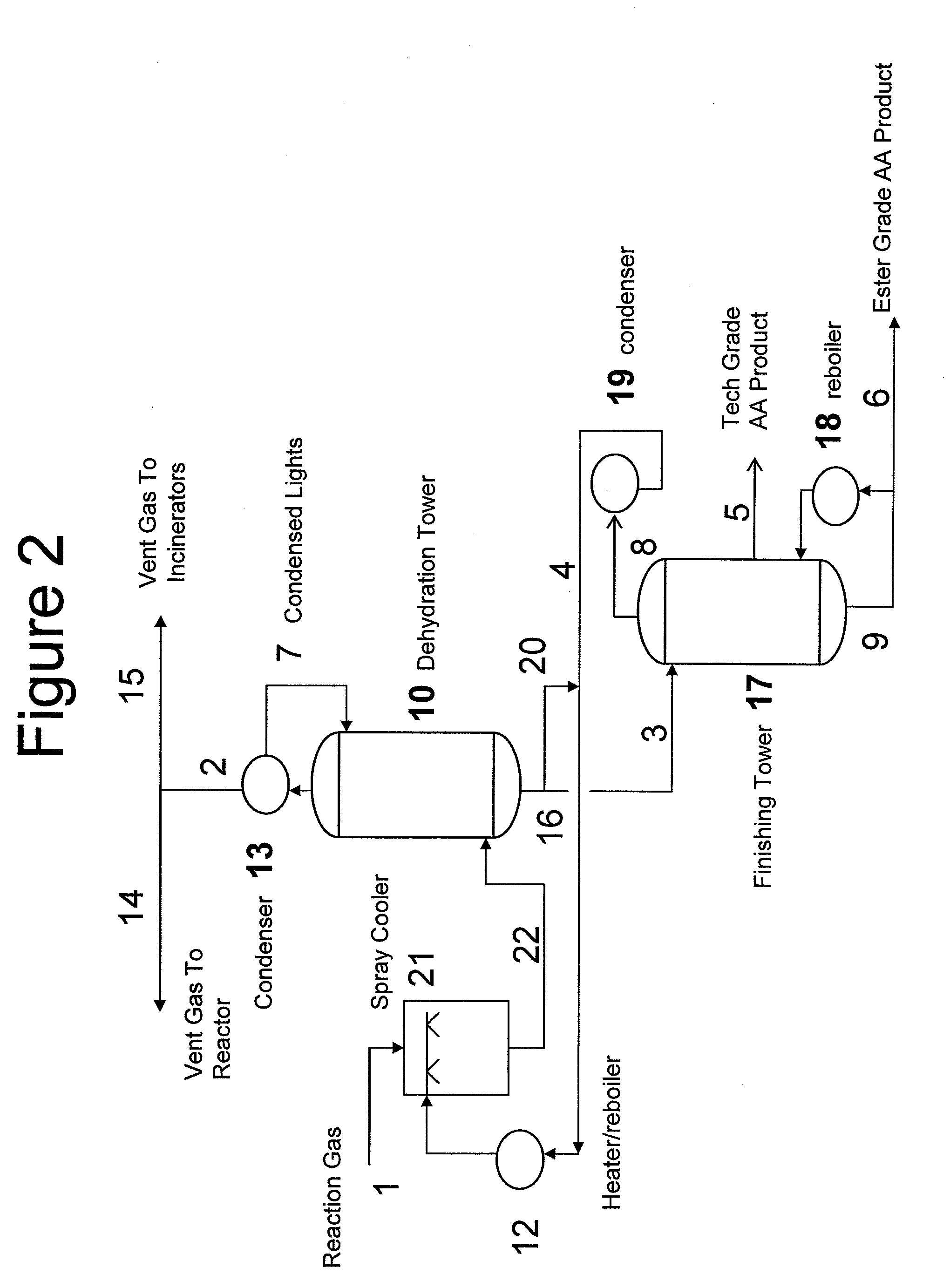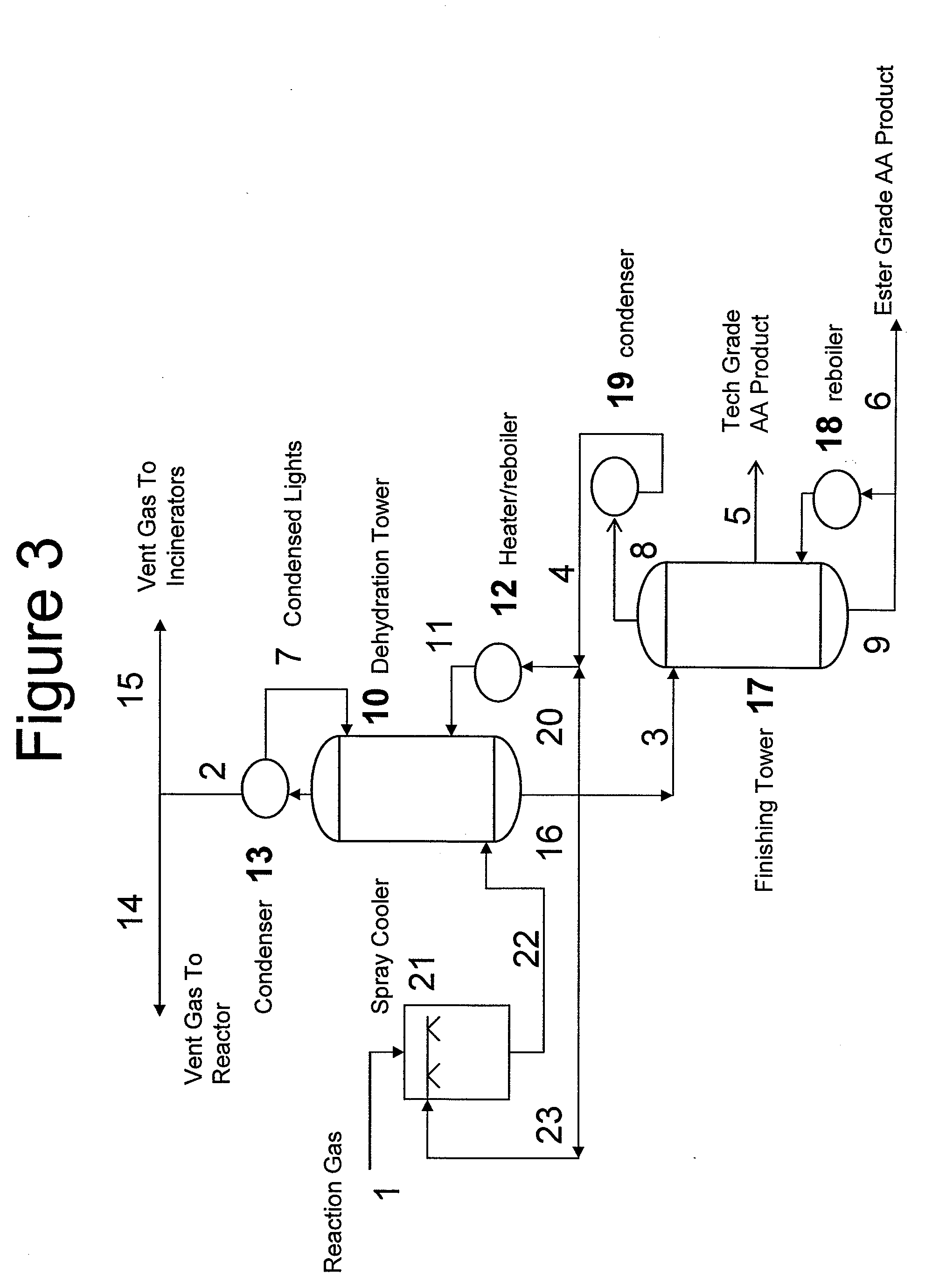Process for Producing Acrylic Acid
a technology of acrylic acid and purification tower, which is applied in the preparation of carboxylic compounds, organic chemistry, chemistry apparatus and processes, etc., can solve the problems of high capital and operation costs of purification towers, add to the production cost of acrylic acid, and inhibit the production of acrylic acid, so as to reduce operational costs, reduce capital expenditures, and reduce operating costs
- Summary
- Abstract
- Description
- Claims
- Application Information
AI Technical Summary
Benefits of technology
Problems solved by technology
Method used
Image
Examples
example 1
[0072]A separation process is conducted according to the process scheme shown in FIG. 1. A gaseous reaction mixture (3100 g / hr), Stream 1, is introduced into the dehydration column of a separation process. The gaseous reaction mixture contains acrylic acid, which is obtained from the catalytic gas phase oxidation of acrylic acid precursors, and has a temperature of 177° C., a pressure of 18.7 psia, and a composition of 16.6% acrylic acid, 0.9% acetic acid, 6.8% water, 75.2% noncondensibles, and 0.5% other reaction by-products.
[0073]The overhead vapor from the dehydration column is partially condensed in a condenser. The vapor stream from the partial condenser (2590 g / hr), Stream 2, has a temperature of 54° C., a pressure of 16.7 psia, and a composition of 0.5% acrylic acid, 1.1% acetic acid, 8.4% water, 89.9% noncondensibles, and 0.1% other reaction by-products. The majority of water in Stream 1 is removed via Stream 2.
[0074]The bottoms stream from the dehydration column (1420 g / hr)...
example 2
Finishing Column Vapor Side Stream Lab Example
[0078]A continuous lab distillation column is assembled consisting of a thermo-siphon reboiler equipped with a 1 inch diameter by one foot long section of 0.24 inch stainless steel Pro-Pak™ packing. A vapor side stream apparatus is attached to the top of the packing section. A 20 tray 1 inch Oldershaw section is then placed on top of the vapor side stream apparatus. The top of the column is equipped with a feed section that fed preheated liquid to the top tray of the Oldershaw section via a pump and feed vessel arrangement. An electrically traced total overhead take-off line is attached to the top of the column and this fed vapor directly to a condenser along with an inhibitor solution which is introduced at the top of the condenser. The condenser is connected to a receiver that has been equipped with a vacuum line that connected to a vacuum pump. A pump is used to continually remove liquid from the receiver into a collection vessel. A s...
example 3
Finishing Column Liquid Side Stream
[0080]An Oldershaw column similar to the one used Example 2 is assembled, but the packed column section is replaced with a 5 tray 1 inch Oldershaw section and the vapor side stream section is replaced with a liquid side stream section which does not have inhibitor injection. The operating parameters for three 30-minute mass balance runs are reported in Table 3A.
TABLE 3AFinishing Column Operating ParametersRun456Feed to top of tower (g)325324324Overhead product (g)247246248Liquid side stream product (g)575757Residue product (g)212121Feed temperature (C.)706868Overhead vapor temperature (C.)747271Reboiler temperature (C.)989898Overhead pressure (torr)110110110Air injection into reboiler (cc / min)10.210.210.2Overhead receiver inhibitor flow (mL / min)*0.10.10.1*The inhibitor solution is 1% 4-hydroxy-TEMPO and 0.1% Mn(OAc)4 in acrylic acid.
[0081]The stream compositions for the three 30-minute mass balance runs are shown in Tables 3B-E.
TABLE 3BFeed Stream ...
PUM
| Property | Measurement | Unit |
|---|---|---|
| temperature | aaaaa | aaaaa |
| temperature | aaaaa | aaaaa |
| molar ratio | aaaaa | aaaaa |
Abstract
Description
Claims
Application Information
 Login to View More
Login to View More - R&D
- Intellectual Property
- Life Sciences
- Materials
- Tech Scout
- Unparalleled Data Quality
- Higher Quality Content
- 60% Fewer Hallucinations
Browse by: Latest US Patents, China's latest patents, Technical Efficacy Thesaurus, Application Domain, Technology Topic, Popular Technical Reports.
© 2025 PatSnap. All rights reserved.Legal|Privacy policy|Modern Slavery Act Transparency Statement|Sitemap|About US| Contact US: help@patsnap.com



